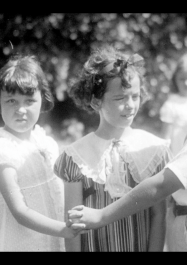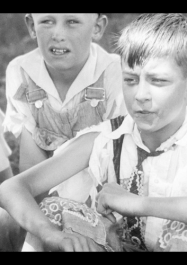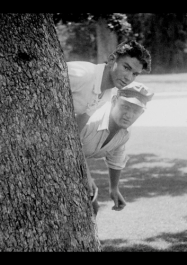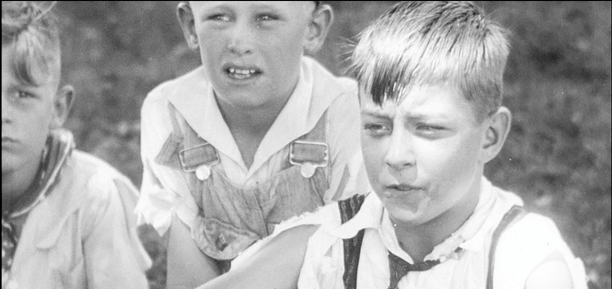In Spring 2010, The Moving Image published “The Itinerant Issue,” an entire issue dedicated to the burgeoning field of study of itinerant filmmaking and exhibition practices. In the excerpt below, archivist Dwight Swanson weaves together the childhood recollections of people who acted in one of Melton Barker’s many productions of THE KIDNAPPERS FOIL.
Because itinerant filmmakers operated at the furthest fringes of industrial filmmaking, they left few records behind and were rarely mentioned in industry literature of the time. Most of the information about these films is found almost entirely in local newspaper articles and the advertisements taken out by the filmmakers themselves. Unfortunately, because itinerant filmmaking peaked in the 1930s, the discovery of a new filmmaker is often followed by a search that ends with the discovery of his or her obituary. The lack of written information about this phenomenon makes oral history one of the more fruitful methodologies for studying local filmmaking because it both unearths facts about the productions and reveals the feelings that the films evoked for participants at the time of their creation and in intervening years.
The pages that follow are excerpts from interviews, both published and unpublished, with the subjects and makers of four narrative itinerant series. These oral histories show the diverse and sometimes contradictory stories to which the productions gave rise. By uniting them here, I hope to provide a new perspective on a genre that has been all but lost to film history.
***
Melton Barker and The Kidnappers Foil
 Melton Barker was the most widely traveled and long-lasting of the itinerant film producers, returning again and again to his series The Kidnappers Foil for more than four decades. Barker clung to his original 1930s script with amazing tenacity over the years, keeping it virtually unchanged into the 1970s. The barebones plot revolves around the kidnapping and attempted ransoming of “Betty Davis,” a local girl who is eventually rescued by a gang of local kids. The script was designed to get as many children on screen as possible, with one spoken line per child, to lure their parents and friends into the theaters as well as to collect the fee that Barker charged for so-called acting lessons.
Melton Barker was the most widely traveled and long-lasting of the itinerant film producers, returning again and again to his series The Kidnappers Foil for more than four decades. Barker clung to his original 1930s script with amazing tenacity over the years, keeping it virtually unchanged into the 1970s. The barebones plot revolves around the kidnapping and attempted ransoming of “Betty Davis,” a local girl who is eventually rescued by a gang of local kids. The script was designed to get as many children on screen as possible, with one spoken line per child, to lure their parents and friends into the theaters as well as to collect the fee that Barker charged for so-called acting lessons.
As he crisscrossed America, Barker frequently returned to the same towns to film different versions of The Kidnappers Foil. He traveled to the Texas Panhandle town of Childress twice, once in 1936 and again twelve years later. Childress’s two Betty Davises were Dory Dugan, who starred in the 1936 version, and Eugenia “Genie” Houseman, featured in the 1948 film. Dugan, who was interviewed by Caroline Frick and American Public Radio’s Michael May in 2006, said that her memories revolved largely around going to “a big house on the other side of town” for the filming. “That was a big treat for me,” she said. “It was very expensive, since we had nothing. We were very poor people.”
Genie Houseman’s recollections of her participation were somewhat hazy at first, but over the course of my 2009 interview with her, she was able to recall many memories of the film. . . Barker, never missing an opportunity to play up his fictitious Hollywood connections, occasionally attempted to convince the parents that their children were on the way to stardom. “Later, it must have been when they brought the movie back [for the screening],” remembered Houseman, “he offered my mother eight hundred dollars to bring me to Hollywood. My mother was a schoolteacher, and she said, ‘Oh, no, no, no.’”
Although screenings of The Kidnappers Foil, as well as most other itinerant film series, were generally held as soon after filming as possible to capitalize on the publicity that had accompanied the production, Houseman’s recollection was that
“ten years later they showed it at the [Childress] Theater for the first time—I would have been seventeen at the time. I remembered crawling down in my seat because it was a little embarrassing. My mother didn’t know that they were showing it, so she never saw it. They said that they were going to show it every ten years, but I guess they just left it in the theater, because that’s where they found it later.”
 For those itinerant film actors lucky enough to see themselves on the screen again decades later, the impact of the childhood experience is often multiplied by both the passage of time and the ability to share it with their children and grandchildren. Judy White was five years old when she played the Betty Davis role in the 1947 Odessa, Texas, version of The Kidnappers Foil. She spoke with me by phone from her home in Grand Prairie, Texas, more than six decades after her star turn, but her memories of the film were still fresh, and she grew more and more animated as she recalled the story:
For those itinerant film actors lucky enough to see themselves on the screen again decades later, the impact of the childhood experience is often multiplied by both the passage of time and the ability to share it with their children and grandchildren. Judy White was five years old when she played the Betty Davis role in the 1947 Odessa, Texas, version of The Kidnappers Foil. She spoke with me by phone from her home in Grand Prairie, Texas, more than six decades after her star turn, but her memories of the film were still fresh, and she grew more and more animated as she recalled the story:
“. . . It was very exciting, because I really thought that I was a star at that point, so going to the premiere was wonderful. And I don’t know if they sold tickets, but I know that those of us who were in the film got in first, and I thought that was pretty special. And they had lots of lights and there was lots of noise and a big crowd outside the theater as we went in. So we really felt “Hollywood.” I don’t know that they had the big lights that turned around, but it was a well-lighted place for downtown Odessa. It was very special for somebody my age. Whether as an adult I would have thought that was a big commotion or not, I don’t know, but I went expecting it to be special, and I thought it was. I don’t know if it was like a premiere or not, but that’s the way I felt about it. . . Everybody thought it was a fun thing to do. I’ve thought about it through the years, just off and on, thinking, “Wasn’t that a funny thing that we did?” I bragged to my grandchildren that I’d been in the movies, you know? They were impressed! It was a fun thing, and a fun thing to remember.”
The once flourishing genre of itinerant films had long been forgotten by 1972, so reporter Owen Taylor, perhaps anticipating skeptical readers’ feelings that the entire operation might be a scam, also interviewed two mothers of children who appeared in the film:
“A lot of people think it’s fake or something,” says Mrs. Roy Peacock, whose 6-year-old Brain [sic] is in the cast, “but we think it will be a good experience for Brain. He really wants to do it, too.” Mrs. Lyndol Ellison says that she told Barker she thought it all sounded like “a moneymaking” scheme when she registered daughter Penny, 10, and son Scott, 8. “He said that he made money from this, alright, but he said that he also had to pay for his expenses. But if he does what he promises it will be worth it,” she says. Barker, apparently responding to Mrs. Ellison’s comment about his movies being merely a money-making gimmick, replied, “I get that sort of thing. It usually comes from ignorant people who don’t know what’s involved. Actually,I could probably make some money at this sort of thing if I didn’t have to buy film and have it processed,” which he estimated cost him four hundred to five hundred dollars.
 Two of the other stars of the Cleveland The Kidnappers Foil, Laura Smith Legge and her brother Lance Smith, were eleven and six years old, respectively, at the time of the film’s production. [Laura recalls:]
Two of the other stars of the Cleveland The Kidnappers Foil, Laura Smith Legge and her brother Lance Smith, were eleven and six years old, respectively, at the time of the film’s production. [Laura recalls:]
“Mr. Barker had us to sit on top of a picnic table in a row and also on the bench part of the table. One by one, he told us what he wanted us to say. When he came to me, he told me to say “Come up and see me sometime, boys” [like Mae West] and to put my hand behind my head and push my hair up like I was flirting . . . then he told the boys to say “Woo-wooo” after my line. Well, that embarrassed the stuffing out of all of us, as we were at the age that flirting didn’t come that easy yet. Then he gave out the rest of the lines and told us to speak up and not to squint our eyes (it was a sunny day). He set his camera up on a tripod and the filming began. He played the part of the robber that day and some kid’s father played the Dad. We did several takes and that took the better part of the day. Parents were standing on the edge of the filming area watching intently. I remember everyone having a good time. Mr. Barker was a very nice man and he enjoyed every minute of it.
***
Oral history is a technique that is used occasionally in traditional cinema studies, but historians of itinerant film do not just benefit from interviews with the participants, they require them. This is not just because of the historiographic limitations mentioned earlier but rather because itinerant films derive so much of their importance, and perhaps even their primary meaning, from the reactions of the audience. These screenings, which were often literally a single show but at the most a week of shows in the local theater, were designed to be an event for the local people in attendance, even if the film itself was just a ten-minute short that played in the program where the cartoon would usually go. Ultimately, it is only through listening to the impressions of the participants that we can begin to understand these films.
***
Dwight Swanson is a specialist in amateur film and regional film production and has lectured and written extensively on home movies and amateur film, including presentations at the Orphan Film Symposium, the Northeast Historic Film Summer Symposium, the University Film and Video Association, and the Association of Moving Image Archivists’ annual conferences. He is a past member of the National Film Preservation Board, and is past co-chair of the Association of Moving Image Archivists’ Small Gauge and Amateur Film Interest Group and the Regional Audio-Visual Archivists’ Interest Group. He sits on the Board of Directors of the Center for Home Movies.
Source: The Moving Image, Volume 10, Number 1, Spring 2010, pp. 102-114.


